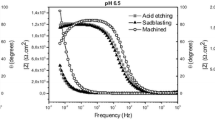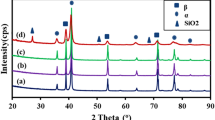Abstract
This study investigated the electrochemical behavior of the Ti6Al4V alloy under the influence of dynamic action of mouthwashes. Ti6Al4V alloy disks (n = 5) were dynamically exposed to mouthwashes (0.12% chlorhexidine digluconate [CHX], cetylpyridinium chloride [CC], and hydrogen peroxide [HP]) by immersion 3 times a day for 1 min. Artificial saliva [AS] is a control solution. The electrochemical behavior of the Ti6Al4V (n = 5) was tested at the baseline, and after 7 and 14 days of mouthwashes dynamic action. Surfaces characteristics were investigated using scanning electron microscopy (SEM), energy-dispersive spectroscopy, surface roughness, and Vickers microhardness. CC had the highest values of polarization resistance (Rp), and CHX reduced the capacitance values (Q) compared to the other groups (p < 0.05). HP generated the lowest Rp values in all periods, and the highest Q values after 14 days immersion (p < 0.05). CC and CHX did not alter the alloy potentiodynamic curves when compared to AS. HP increased the corrosion and passivation current densities, and the corrosion rate in relation to the other groups (p < 0.05). SEM micrographs showed minors surface changes with the presence of pitting corrosion for HP. No differences were found for roughness and microhardness after all immersion periods (p > 0.05). Dynamic mouthwash simulation with HP impairs the corrosion stability of Ti6Al4V alloy, and CC presents the greatest electrochemical stability over time. Our data shed light on how the dynamic action of mouthwashes affects the Ti electrochemical behavior aiming at ensuring a safer indication for patients receiving dental implant.







Similar content being viewed by others
References
Oliveira NT, Guastaldi PSF, Perrotti V et al (2013) Biomedical Ti-mo alloys with surface machined and modified by laser beam: biomechanical, histological, and histometric analysis in rabbits. Clin Implant Dent Relat Res 15(3):427–437. https://doi.org/10.1111/j.1708-8208.2011.00354.x
Oliveira NT, Guastaldi AC (2009) Electrochemical stability and corrosion resistance of Ti-Mo alloys for biomedical applications. Acta Biomater. England 5:399–405. https://doi.org/10.1016/j.actbio.2008.07.010
Branemark PI, Hansson BO, Adell R et al (1977) Osseointegrated implants in the treatment of the edentulous jaw. Experience from a 10-year period. Scand J Plast Reconstr Surg Suppl 16:1–132
Ekelund JA, Lindquist LW, Carlsson GE et al (2003) Implant treatment in the edentulous mandible: a prospective study on Branemark system implants over more than 20 years. Int J Prosthodont 16(6):602–608
Queiroz TP, Souza FA, Guastaldi AC et al (2013) Commercially pure titanium implants with surfaces modified by laser beam with and without chemical deposition of apatite. Biomechanical and topographical analysis in rabbits. Clin Oral Implants Res 24(8):896–903. https://doi.org/10.1111/j.1600-0501.2012.02471.x
Pi Y, Faure J, Agoda-Tandjawa G et al (2013) Microstructural characterization of Ti-6Al-4V alloy subjected to the duplex SMAT/plasma nitriding. Microsc Res Tech 76(9):897–903. https://doi.org/10.1002/jemt.22245
Faverani LP, Barão VAR, Ramalho-Ferreira G et al (2014) Effect of bleaching agents and soft drink on titanium surface topography. J Biomed Mater Res B Appl Biomater 102(1):22–30. https://doi.org/10.1002/jbm.b.32949
Barao VA, Mathew MT, Assunção WG et al (2012) Stability of cp-Ti and Ti-6Al-4V alloy for dental implants as a function of saliva pH - an electrochemical study. Clin Oral Implants Res 23(9):1055–1062. https://doi.org/10.1111/j.1600-0501.2011.02265.x
Ho WF, Ju CP, Lin JH (1999) Structure and properties of cast binary Ti-Mo alloys. Biomaterials Netherlands 20:115–122. https://doi.org/10.1016/s0142-9612(99)00114-3
Gosau M, Hahnel S, Schwarz F et al (2010) Effect of six different peri-implantitis disinfection methods on in vivo human oral biofilm. Clin Oral Implants Res Denmark 2:866–872. https://doi.org/10.1111/j.1600-0501.2009.01908.x
Pizzo G, Guiglia R, Imburgia M et al (2006) The effects of antimicrobial sprays and mouthrinses on supragingival plaque regrowth: a comparative study. J Periodontol 77(2):248–256. https://doi.org/10.1902/jop.2006.050116
Hoenderdos NL, Rosema NAM, Slot DE et al (2009) The influence of a hydrogen peroxide and glycerol containing mouthrinse on plaque accumulation: a 3-day non-brushing model. Int J Dent Hyg. England 7:294–298. https://doi.org/10.1111/j.1601-5037.2009.00367.x
Marinone MG, Savoldi E (2000) Chlorhexidine and taste Influence of mouthwashes concentration and of rinsing time. Minerva Stomatol 49(5):221–226
Wicht MJ, Haak R, Lummert D et al (2003) Treatment of root caries lesions with chlorhexidine-containing varnishes and dentin sealants. Am J Dent, 25A-30A.
Sreenivasan PK, Haraszthy VI, Zambon JJ (2013) Antimicrobial efficacy of 0.05% cetylpyridinium chloride mouthrinses. Lett Appl Microbiol 56(1):14–20. https://doi.org/10.1111/lam.12008
Rosema NA, Timmerman MF, Versteeg PA et al (2008) Comparison of the use of different modes of mechanical oral hygiene in prevention of plaque and gingivitis. J Periodontol 79(8):1386–1394. https://doi.org/10.1902/jop.2008.070654
De Waal YC et al (2013) Implant decontamination during surgical peri-implantitis treatment: a randomized, double-blind, placebo-controlled trial. J Clin Periodontol 40(2):186–195. https://doi.org/10.1111/jcpe.12034
Hossainian N, Raghoebar GM, Slater JJRH et al (2011) The effects of hydrogen peroxide mouthwashes on the prevention of plaque and gingival inflammation: a systematic review. Int J Dent Hyg 9(3):171–181. https://doi.org/10.1111/jcpe.12034
Milosev I, Kapun B, Selih VS (2013) The effect of fluoride ions on the corrosion behaviour of Ti metal, and Ti6-Al-7Nb and Ti-6Al-4V alloys in artificial saliva. Acta Chim Slov Slovenia 60:543–555
Quaranta A, Ronconi LF, Di Carlo F et al (2010) Electrochemical behaviour of titanium in ammine and stannous fluoride and chlorhexidine 0.2 percent mouthwashes. Int J Immunopathol Pharmacol 23:335–343. https://doi.org/10.1177/039463201002300132
Faverani LP, Barao VAR, Pires MFA et al (2014) Corrosion kinetics and topography analysis of Ti-6Al-4V alloy subjected to different mouthwash solutions. Mater Sci Eng C Mater Biol Appl 43:1–10. https://doi.org/10.1016/j.msec.2014.06.033
Alves-Rezende MC, Alves APR, Codaro EN et al (2007) Effect of commercial mouthwashes on the corrosion resistance of Ti-10Mo experimental alloy. J Mater Sci Mater Med 18(1):149–154. https://doi.org/10.1007/s10856-006-0674-9
Muguruma T, Iijima M, Brantley WA et al (2011) Effects of sodium fluoride mouth rinses on the torsional properties of miniscrew implants. Am J Orthod Dentofacial Orthop 139:588–593. https://doi.org/10.1016/j.ajodo.2009.05.042
Schiff N, Grosgogeat B, Lissac M et al (2002) Influence of fluoride content and pH on the corrosion resistance of titanium and its alloys. Biomaterials 23(9):1995–2002. https://doi.org/10.1016/s0142-9612(01)00328-3
Barão VA, Mathew MT, Assunção WG et al (2011) The role of lipopolysaccharide on the electrochemical behavior of titanium. J Dent Res 90(5):613–618. https://doi.org/10.1177/0022034510396880
Faverani LP, Assunção WG, de Carvalho PS et al (2014) Effects of dextrose and lipopolysaccharide on the corrosion behavior of a Ti-6Al-4V alloy with a smooth surface or treated with double-acid-etching. PLoS ONE 9(3):e93377. https://doi.org/10.1371/journal.pone.0093377
Landolt D, Stemp MS (2011) Electrochemical methods in tribocorrosion: a critical appraisal. Electrochim Acta 46(24–25):3913–3929. https://doi.org/10.1016/S0013-4686(01)00679-X
Assuncao WG, Jorge JRP, Dos Santos PH et al (2011) The effect of mechanical cycling and different misfit levels on Vicker’s microhardness of retention screws for single implant-supported prostheses. J Prosthodont 20(7):523–527. https://doi.org/10.1111/j.1532-849X.2011.00753.x
Yu F, Addison O, Davenport AJ (2015) A synergistic effect of albumin and H2O2 accelerates corrosion of Ti6Al4V. Acta Biomater 26:355–365. https://doi.org/10.1016/j.actbio.2015.07.046
Gopal V, Manivasagam G (2020) Wear – Corrosion synergistic effect on Ti–6Al–4V alloy in H2O2 and albumin environment. J Alloys Compd 830:154539. https://doi.org/10.1016/j.jallcom.2020.154539
Bearinger JP, Orme CA, Gilbert JL (2003) Effect of hydrogen peroxide on titanium surfaces: In situ imaging and step-polarization impedance spectroscopy of commercially pure titanium and titanium, 6-aluminum, 4-vanadium. J Biomed Mater Res - Part A 67:702–712. https://doi.org/10.1002/jbm.a.10116
Khamis A, Saleh MM, Awad MI (2013) Synergistic inhibitor effect of cetylpyridinium chloride and other halides on the corrosion of mild steel in 0.5M H2SO4. Corros Sci 66:343–349. https://doi.org/10.1016/j.corsci.2012.09.040
ArockiaSelvi J, Kamaraj P, Arthanareeswari M et al (2019) Effect of Cetylpyridinium chloride on corrosion inhibition of mild steel in chloride environment. Mater Today Proc. https://doi.org/10.1016/j.matpr.2019.04.146
Deyab MA, Keera ST, El Sabagh SM (2011) Chlorhexidine digluconate as corrosion inhibitor for carbon steel dissolution in emulsified diesel fuel. Corros Sci 53:2592–2597. https://doi.org/10.1016/j.corsci.2011.04.018
Pavlic A, Perissinotto F, Turco G et al (2019) Do Chlorhexidine and probiotics solutions provoke corrosion of orthodontic mini-implants? An in vitro study. Int J Oral Maxillofac Implants 34:1379–1388. https://doi.org/10.11607/jomi.7392
Danaei SM, Safavi A, Roeinpeikar SMM et al (2011) Ion release from orthodontic brackets in 3 mouthwashes: An in-vitro study. Am J Orthod Dentofac Orthop 139:730–734. https://doi.org/10.1016/j.ajodo.2011.03.004
Peñarrieta-Juanito G, Sordi MB, Henriques B et al (2019) Surface damage of dental implant systems and ions release after exposure to fluoride and hydrogen peroxide. J Periodontal Res 54:46–52. https://doi.org/10.1111/jre.12603
Licausi MP, Igual Muñoz A, Amigó Borrás V (2013) Influence of the fabrication process and fluoride content on the tribocorrosion behaviour of Ti6Al4V biomedical alloy in artificial saliva. J Mech Behav Biomed Mater 20:137–148. https://doi.org/10.1016/j.jmbbm.2013.01.019
Olvano I, Garcia I, Conde A, Tato W, Aginagalde A (2015) Influence of fluoride content and pH on corrosion and tribocorrosion behaviour of Ti13Nb13Zr alloy in oral environment. J Mech Behav Biomed Mater 49:186–196. https://doi.org/10.1016/j.jmbbm.2015.05.008
Author information
Authors and Affiliations
Corresponding author
Ethics declarations
Conflict of interest
All authors declare that they have no conflict of interest.
Additional information
Publisher's Note
Springer Nature remains neutral with regard to jurisdictional claims in published maps and institutional affiliations.
Rights and permissions
About this article
Cite this article
Sousa, C.A., Cordeiro, J.M., Silva, A.O. et al. Dynamic Action of Mouthwashes Affects the Electrochemical Behavior of Ti6Al4V Alloy. J Bio Tribo Corros 7, 158 (2021). https://doi.org/10.1007/s40735-021-00591-8
Received:
Revised:
Accepted:
Published:
DOI: https://doi.org/10.1007/s40735-021-00591-8




